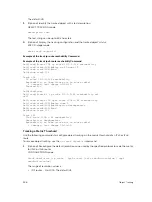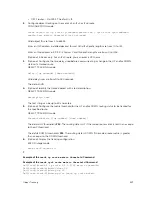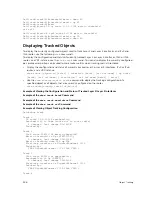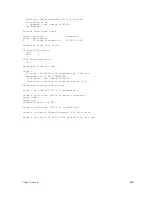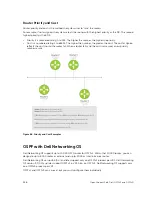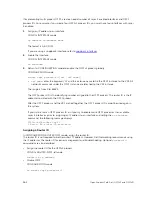
example, if you create five OSPFv2 processes on a system, there must be at least five interfaces assigned
in Layer 3 mode.
Each OSPFv2 process is independent. If one process loses adjacency, the other processes continue to
function.
Processing SNMP and Sending SNMP Traps
Though there are may be several OSPFv2 processes, only one process can process simple network
management protocol (SNMP) requests and send SNMP traps.
NOTE: SNMP get request corresponding to the OspfNbrOption feild in the OspfNbrTable returns a
value of 66.
RFC-2328 Compliant OSPF Flooding
In OSPF, flooding is the most resource-consuming task. The flooding algorithm described in RFC 2328
requires that OSPF flood LSAs on all interfaces, as governed by LSA’s flooding scope (refer to Section 13
of the RFC.)
When multiple direct links connect two routers, the RFC 2328 flooding algorithm generates significant
redundant information across all links.
By default, Dell Networking OS implements an enhanced flooding procedure which dynamically and
intelligently detects when to optimize flooding. Wherever possible, the OSPF task attempts to reduce
flooding overhead by selectively flooding on a subset of the interfaces between two routers.
Enabling RFC-2328 Compliant OSPF Flooding
To enable OSPF flooding, use the following command.
When you enable this command, it configures Dell Networking OS to flood LSAs on all interfaces.
• Enable RFC 2328 flooding.
ROUTER OSPF mode
flood-2328
Example of Viewing the Debug Log for Flooding Behavior
To confirm RFC 2328 flooding behavior, use the
debug ip ospf packet
command. The following
example shows no change in the updated packets (shown in bold).
ACKs 2 (shown in bold) is printed only for ACK packets.
00:10:41 : OSPF(1000:00):
Rcv. v:2 t:5(LSAck) l:64
Acks 2
rid:2.2.2.2
aid:1500 chk:0xdbee aut:0 auk: keyid:0 from:Vl 1000
LSType:Type-5 AS External id:160.1.1.0 adv:6.1.0.0 seq:0x8000000c
LSType:Type-5 AS External id:160.1.2.0 adv:6.1.0.0 seq:0x8000000c
00:10:41 : OSPF(1000:00):
Rcv. v:2 t:5(LSAck) l:64
Acks 2
rid:2.2.2.2
aid:1500 chk:0xdbee aut:0 auk: keyid:0 from:Vl 100
LSType:Type-5 AS External id:160.1.1.0 adv:6.1.0.0 seq:0x8000000c
LSType:Type-5 AS External id:160.1.2.0 adv:6.1.0.0 seq:0x8000000c
00:10:41 : OSPF(1000:00):
Rcv. v:2 t:4(LSUpd) l:100 rid:6.1.0.0
aid:0 chk:0xccbd aut:0 auk: keyid:0 from:Gi 10/21
Number of LSA:2
LSType:Type-5 AS External(5) Age:1 Seq:0x8000000c id:170.1.1.0 Adv:6.1.0.0
Netmask:255.255.255.0 fwd:0.0.0.0 E2, tos:0 metric:0
Open Shortest Path First (OSPFv2 and OSPFv3)
559
Summary of Contents for Z9000
Page 1: ...Dell Configuration Guide for the Z9000 System 9 7 0 0 ...
Page 80: ...grub reboot 80 Management ...
Page 128: ... 0 Te 1 1 Te 1 2 rx Flow N A N A 128 Access Control Lists ACLs ...
Page 491: ...Figure 70 Configuring OSPF and BGP for MSDP Multicast Source Discovery Protocol MSDP 491 ...
Page 496: ...Figure 73 MSDP Default Peer Scenario 1 496 Multicast Source Discovery Protocol MSDP ...
Page 497: ...Figure 74 MSDP Default Peer Scenario 2 Multicast Source Discovery Protocol MSDP 497 ...
Page 498: ...Figure 75 MSDP Default Peer Scenario 3 498 Multicast Source Discovery Protocol MSDP ...
Page 760: ...Figure 100 Single and Double Tag TPID Match 760 Service Provider Bridging ...
Page 761: ...Figure 101 Single and Double Tag First byte TPID Match Service Provider Bridging 761 ...


